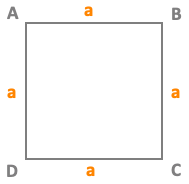Area of a square |

|
|
|
|
A side of the square = a AB = BC = CD = DA ExampleABCD is a square with side a = 4 cmArea A of the square ABCD = a x a = 4 x 4 = 16 cm² Calculate the area of a square |
SquareA square is a geometric shape with four equal sides, four right angles, and sides meeting at 90-degree angles. Its area is calculated by multiplying the length of one side by itself.A square is a polygon characterized by four congruent sides and four right angles. Each interior angle measures 90 degrees. Its properties include symmetry, equal diagonals, and a calculated area obtained by squaring the length of one side. In Euclidean geometry, a fundamental shape with practical applications in mathematics and various fields. Properties of a squareEqual sides: all four sides of a square are of equal length.Right angles: each interior angle measures 90 degrees, forming right angles. Congruent diagonals: the diagonals bisect each other at right angles and are of equal length. Symmetry: a square exhibits symmetry with respect to its center and each of its sides. Diagonal properties: diagonals are equal in length, and the square can be divided into four congruent right-angled triangles. Perimeter: the perimeter of a square is four times the length of one side. Area formula: the area is calculated as the square of the length of one side. Vertex angles: all four vertex angles are right angles. Interior angles: the sum of interior angles is always 360 degrees. Regular polygon: a square is a regular polygon, meeting criteria for both equilateral and equiangular properties. Inscribed circle: a square has a unique property where a circle can be inscribed within it, touching the midpoint of each side. Circumcircle: the center of the square is also the center of the circumcircle (the circle passing through all four vertices). Angle bisector: the diagonals of a square bisect each other's angles, creating congruent adjacent angles. Equal opposite angles: opposite angles in a square are equal. Orthodiagonal: the diagonals are orthodiagonal, meaning they intersect at right angles. ExamplesThe area (A) of a square can be calculated using the formula:A = (side length)2 Side length = 5 units:A = 52 = 25 units2Side length = 8.2 meters:A = 8.22 = 67.24 m2Side length = 12 inches:A = 122 = 144 in2Side length = 2.5 centimeters:A = 2.52 = 6.25 cm2Side length = 10 feet:A = 102 = 100 ft2 |